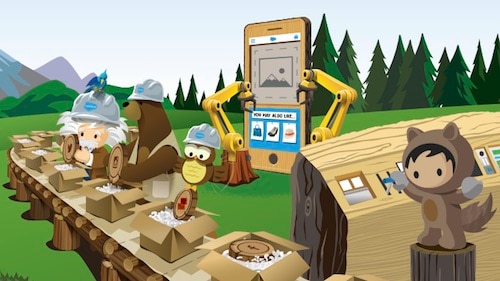Retailers fight tooth and nail to adapt business strategies for the next era of shopping. New data shows the average ecommerce visit is shorter than ever at four minutes and 12 seconds, and mobile traffic is increasingly beating desktop. That means retailers must reduce friction and create seamless experiences if they want to grow revenue.
Consumers in 2019 seek out brands that offer convenience, great service, and exciting, unique products. In scanning today’s retail landscape, here are eight brilliant ways retailers offer friction-free experiences that are both smart for business and smart for winning shoppers’ long-term loyalty.
1. Retailers offer easy-to-use mobile wallets. Unfortunately, $200 billion in ecommerce sales are lost each year due to checkout friction. At the same time, order share and traffic share are increasingly going mobile. To combat the pain point of poor mobile checkout, retailers are increasingly adopting Apple Pay, PayPal, and other solutions. There’s a huge upside: For sites with mobile wallets, mobile conversion rate is increasing 2x, and mobile wallet users check out 85 seconds faster. It’s a checkout change that will make mobile consumers happier.

2. Stores offer limitless services. We’ve all seen the headlines about store closures and retailer bankruptcy. What about the stores that have lines out the door and ample online buzz? Forward-thinking retailers are breaking down traditional customer service barriers to create seamless in-store experiences. For example, Nike has implemented curbside pickup for online orders. Best Buy will send a team member to your house to suggest new technology. Nordstrom even has tested 24-hour return kiosks. And Walmart has teamed up with Handy to offer TV mounting services. The best brands think holistically about where inconvenience exists in their customer experience – and seamlessly remove it.
3. The subscription model goes mainstream. Subscriptions today go beyond Netflix and Spotify. Research shows 15 percent of online shoppers have signed up for one or subscriptions to receive recurring products, making the category a $2.6 billion industry. Well-known subscriptions like Stitch Fix, Dollar Shave Club, and Fabletics have been joined by Target, Gap, Stance, and Kidbox. Retailers and brands are getting creative to incur recurring revenue while curating fresh and limited-edition products for their most loyal advocates. Making loyalty easy is key in this new retail ecosystem (see the next point).
4. The loyalty program gets a modern makeover. The benefits of loyalty are a no-brainer. Sixty-six percent of shoppers are more likely to buy from brands and retailers that offer a loyalty program. And in a mystery shopping study of 70+ global stores, nine out of the ten top-scoring brands had clear evidence of a loyalty program throughout the store. Modern loyalty programs aren’t about the points. Sephora, for example, has experience-driven incentives like custom makeovers and a private hotline for its most loyal shoppers. Shinola’s loyalty program, the Foundry, can’t even be joined online; it requires interaction with an associate, making the program truly VIP.

5. Visual search takes out the keyword middleman. Visual search is the new search frontier for consumer products. Keywords and SEO still matter, but customers are now keen on searching with images and comparing different products side-by-side — even before they get to your website. Einstein Visual Search enables your shoppers to snap a picture of a product they see out in the world – whether on a person, on a display, or on Instagram – and find either that exact product or the closest match from your catalog. No need to figure out what to search for, no need to type. Check out our pilot with Rebecca Taylor.
6. Retailers get creative with searchandizing. In addition to visual search, searchandizing is another way for brands to get their products in front of consumers who are in the product research phase. From suggested search results as a user types, to offering what’s trending before someone types a letter, searchandizing is a huge area for innovation and creativity. Check out the way Cole Haan returns the right results for a misspelled “sandles” query.

7. Email transforms into an AI powerhouse. Artificial intelligence may have reached buzzword status in retail, but it’s hard to argue with the business results. One area where retailers leverage AI to great advantage is email (yes, the old tried-and-true digital marketing tactic). Lids used Salesforce Einstein to run a personalized email campaign that saw their open rate increase from 5.9% to 27%. The smarter data focus also allowed Lids to monitor which email subscribers were highly engaged, and which needed a win-back journey to return to the Lids fold.
8. Speed is the modern retailer’s currency. Shoppers don’t have time for slow retail. Need proof? Fifty-nine percent of the top 5% of best-selling ecommerce products change monthly. And 69% of shoppers expect to see brand-new merchandise whenever they visit a site or a store. Smart retailers and brands are moving urgently to compete with that need for speed. For example, Adidas uses an AI-powered chatbot to provide 24-7, always-on self-service. Beauty brand Anastasia Beverly Hills has partnered with influencers across YouTube, Instagram, and even Ru Paul’s Drag Race star Alyssa Edwards to offer limited-edition products that match the newest makeup trends in real time. Speed to market and service is a competitive advantage.
For more insights about the state of today’s shopper, check out Salesforce’s Shopping Index, measuring the shopping activity of half a billion consumers worldwide.




























